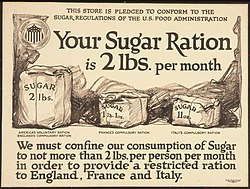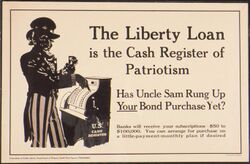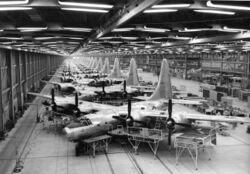War economy
Topic: Social
 From HandWiki - Reading time: 8 min
From HandWiki - Reading time: 8 min
A war economy or wartime economy is the set of contingencies undertaken by a modern state to mobilize its economy for war production. Philippe Le Billon describes a war economy as a "system of producing, mobilizing and allocating resources to sustain the violence." Some measures taken include the increasing of Taylor rates as well as the introduction of resource allocation programs. Approaches to the reconfiguration of the economy differ from country to country.[1]
Many states increase the degree of planning in their economies during wars; in many cases this extends to rationing, and in some cases to conscription for civil defenses, such as the Women's Land Army and Bevin Boys in the United Kingdom during World War II. During total war situations, certain buildings and positions are often seen as important targets by combatants. The Union blockade, Union General William Tecumseh Sherman's March to the Sea during the American Civil War, and the strategic bombing of enemy cities and factories during World War II are all examples of total war.[2]
Concerning the side of aggregate demand, the concept of a war economy has been linked to the concept of "military Keynesianism", in which the government's military budget stabilizes business cycles and fluctuations and/or is used to fight recessions. On the supply side, it has been observed that wars sometimes have the effect of accelerating technological progress to such an extent that an economy is greatly strengthened after the war, especially if it has avoided the war-related destruction. This was the case, for example, with the United States in World War I and World War II. Some economists (such as Seymour Melman) argue, however, that the wasteful nature of much of military spending eventually can hurt technological progress.
War is often used as a last ditch effort to prevent deteriorating economic conditions or currency crises, particularly by expanding services and employment in the military, and by simultaneously depopulating segments of the population to free up resources and restore the economic and social order. A temporary war economy can also be seen as a means to avoid the need for more permanent militarization. During World War II, U.S. President Franklin D. Roosevelt stated that if the Axis powers won, then "we would have to convert ourselves permanently into a militaristic power on the basis of war economy."[3]
United States
The United States has a very complex history with wartime economies. Many notable instances came during the twentieth century in which America's main conflicts consisted of the World Wars, the Korean War, and the Vietnam War.
World War I
In mobilizing for World War I, the United States expanded its governmental powers by creating institutions such as the War Industries Board (WIB) to help with military production.[4] Others, such as the Fuel Administration, introduced daylight saving time in an effort to save coal and oil while the Food Administration encouraged higher grain production and "mobilized a spirit of self-sacrifice rather than mandatory rationing."[4] Propaganda also played a large part in garnering support for topics ranging from tax initiatives to food conservation. Speaking on Four Minute Men, volunteers who rallied the public through short speeches, investigative journalist George Creel stated that the idea was extremely popular and the program saw thousands of volunteers throughout the states.[5]
World War II
In the case of the Second World War, the U.S. government took similar measures in increasing its control over the economy. The Fall of France and the shifting of the front line into the English Channel with the outcome of the looming Battle of Britain uncertain provided the spark needed to begin conversion to a wartime economy with the passing of the Two-Ocean Navy Act in July 1940. The subsequent Attack on Pearl Harbor prolonged and expanded the measures. Washington felt that a greater bureaucracy was needed to help with mobilization.[6] The government raised taxes which paid for half of the war's costs and borrowed money in the form of war bonds to cover the rest of the bill.[4] "Commercial institutions like banks also bought billions of dollars of bonds and other treasury paper, holding more than $24 billion at the war's end."[6] The creation of a handful of agencies helped funnel resources towards the war effort. One prominent agency was the War Production Board (WPB), which "awarded defense contracts, allocated scarce resources – such as rubber, copper, and oil – for military uses, and persuaded businesses to convert to military production."[4]
The United States mass-produced many vehicles, such as ships (i.e. Liberty Ships), aircraft (i.e. North American P-51 Mustang), jeeps (i.e. Willys MB) and tanks (i.e. M4 Sherman).
Two-thirds of the American economy had been integrated into the war effort by the end of 1943.[4] Because of this massive cooperation between government and private entities, it could be argued that the economic measures enacted prior to and during the Second World War helped lead the Allies to victory.
Present day
The United States has been involved in numerous military endeavours within the Middle East and Latin America since the 1960s. Having been in a continuous state of war since the September 11 attacks,[7] they have an annual military budget larger than India, China, Russia, United Kingdom, Germany, Saudi Arabia, and France’s military budgets combined.
Germany
World War I
Germany has experienced economic devastation following both World Wars. While this was not a result of faulty economic planning, it is important to understand the ways that Germany approached reconstruction. In World War I, the German agricultural sector was hit hard by the demands of the war effort. Not only were many of the workers conscripted, but much of the food itself was allocated for the troops leading to a shortage.[8] "German authorities were not able to solve the food scarcity [problem], but implemented a food rationing system and several price ceilings to prevent speculation and profiteering. Unfortunately, these measures did not have the desired success."[8]
World War II
Heading into the Second World War, the Nazis introduced new policies that not only caused the unemployment rate to drop, it created a competent war machine in clear violation of the Treaty of Versailles. The Third Reich implemented a draft and built factories to supply its quickly expanding military. Both of these actions created jobs for many Germans who had been struggling from the economic collapse following World War I.[9] However, it is worth noting that while unemployment rates plummeted, "by 1939, government debt stood at over 40 billion Reichsmarks (equivalent to 151 billion 2009 euros)."[9] During the war, Germany heavily exploited the economies of countries it conquered. The most important among these, according to historians Boldorf and Scherner, was France and "her highly developed economy... [being] one of the biggest in Europe."[10] This is further supported when they later reveal how the French economy provided for 11 percent of Germany's national income (during the occupation) which covered five months of Germany's total income for the war. Using extortion and forced labor, the Nazis siphoned off much of France's economic output. For example, during the early months of the Nazi occupation, the French puppet government was forced to pay a "quartering" fee of twenty million Reichsmarks per day. Supposedly, the fee was payment for the Nazi occupation forces. In reality, the money was used to fuel the Nazi war economy.[10] Germany employed numerous methods to support its war effort. However, due to the Nazis' surrender to the Allies, it is hard to tell what their economic policies would have yielded in the long term.
Other examples
Armenia is another example that followed war economy principles, especially during the 2020 Nagorno-Karabakh war. Armenia is a small country in a blockade in the Caucasus region but still increased its military budget after 2018 reaching $640 million. In 2019 it was 18.8% of the total Armenian budget.[11] Except mobilizing financial resources, Armenia also declared mobilization and concentrated human capital (volunteers, doctors, soldiers).[12]
See also
- Companies by arms sales
- Defense Economics
- Diversionary war
- Economic nationalism
- Economic warfare
- Industrial warfare
- Military–industrial complex
- Mass production
- Permanent war economy
- Resistance economy
- The Climate Mobilization: calls for a WWII–scale economic transformation to combat climate change
- Total war
- War communism
- War effort
- World War Zero
- Wartime propaganda
References
- ↑ Philippe Le Billon, Geopolitics of Resource Wars: Resource Dependence, Governance and Violence (London: Frank Cass, 2005)
- ↑ Durham, Robert B. (2015). Supplying the Enemy: The Modern Arms Industry & the Military–Industrial Complex. Lulu.com. p. 192. ISBN 978-1-329-06755-4. https://books.google.com/books?id=s-LSCQAAQBAJ&pg=PA192.
- ↑ Roosevelt, Franklin Delano. "The Great Arsenal of Democracy". http://www.americanrhetoric.com/speeches/fdrarsenalofdemocracy.html.
- ↑ 4.0 4.1 4.2 4.3 4.4 Henretta, Edwards, Self, James A., Rebecca, Robert O. (2011). America's History. New York: Bedford/St. Martin's. pp. 672+.
- ↑ Creel, George (1920). How We Advertised America: The First Telling of the Amazing Story of the Committee on Public Information That Carried the Gospel of Americanism to Every Corner of the Globe. New York: Harper and Bros.. pp. 84–88, 90–92. https://archive.org/details/howweadvertiseda00cree.
- ↑ 6.0 6.1 Tassava, Christopher. "The American Economy During World War II". EH.net. http://eh.net/encyclopedia/article/tassava.WWII.
- ↑ "Opinion | America's Forever Wars". The New York Times. 23 October 2017. https://www.nytimes.com/2017/10/22/opinion/americas-forever-wars.html.
- ↑ 8.0 8.1 Blum, Matthias (December 2011). "Government Decisions Before and During the First World War and the Living Standards in Germany During a Drastic Natural Experiment". Explorations in Economic History 48 (4): 556–567. doi:10.1016/j.eeh.2011.07.003.
- ↑ 9.0 9.1 Trueman, Chris. "The Nazis and the German Economy". History Learning Site. HistoryLearningSite.co.uk. http://www.historylearningsite.co.uk/nazis_and_the_german_economy.htm.
- ↑ 10.0 10.1 Boldorf, Marcel; Scherner, Jonas (April 2012). "France's Occupation Costs and the War in the East: The Contribution to the German War Economy, 1940-4". Journal of Contemporary History 47 (2): 291–316. doi:10.1177/0022009411431711.
- ↑ "Armenia vs. Azerbaijan: Military Expenditures" (in en). https://hetq.am/en/article/123482.
- ↑ "Armenia declares martial law and mobilization over Nagorno-Karabakh" (in en). Reuters. 2020-09-27. https://www.reuters.com/article/us-armenia-azerbaijan-martial-idUSKBN26I0AG.
Further reading
- Ball, Douglas B. Financial Failure and Confederate Defeat (University of Illinois Press, 1991) online book review
- Le Billon, Dr. Philippe (2005) Geopolitics of Resource Wars: Resource Dependence, Governance and Violence. London: Frank Cass, 288pp
- Caverley, Jonathan D. "The economics of war and peace." The Oxford Handbook of International Security (2018): 304-318 doi.org/10.1093/oxfordhb/9780198777854.013.20
- Daunton, Martin J. "How to pay for the war: state, society and taxation in Britain, 1917–24." English Historical Review 111.443 (1996): 882-919. doi.org/10.1093/ehr/CXI.443.882
- Flores-Macías, Gustavo A., and Sarah E. Kreps. "Political parties at war: A study of American war finance, 1789–2010." American Political Science Review 107.4 (2013): 833-848. online
- Flores-Macías, Gustavo A., and Sarah E. Kreps. "Borrowing support for war: The effect of war finance on public attitudes toward conflict." Journal of Conflict Resolution 61.5 (2017): 997-1020. online
- Gagliano Giuseppe, Economic War, Modern Diplomacy, 2017,[1]
- Gill, David James. The Long Shadow of Default: Britain's Unpaid War Debts to the United States, 1917-2020 (Yale University Press, 2022) [2].
- Goldstein, Joshua S. (2001). War and gender: How gender shapes the war system and vice versa. Cambridge: Cambridge University Press.
- Hall, George J., and Thomas J. Sargent. "Debt and taxes in eight US wars and two insurrections." in The Handbook of Historical Economics (Academic Press, 2021(. 825-880. online
- Kirss, Alexander. "Interest or ideology? Why American business leaders opposed the Vietnam War." Business and Politics 24.2 (2022): 171-187.
- Moeller, Susan. (1999). "Compassion Fatigue", Compassion Fatigue: How the Media Sells Disease, Famine, War and Death. New York & London: Routledge. 6 - 53.
- Poast, Paul. "Beyond the 'sinew of war': The political economy of security as a subfield." Annual Review of Political Science 22 (2019): 223-239. online
- Poast, Paul. "Economics and War." in Understanding War and Peace (2023): 175+ online.
- Saylor, Ryan, and Nicholas C. Wheeler. "Paying for war and building states: The coalitional politics of debt servicing and tax institutions." World Politics 69.2 (2017): 366-408. On South America in 19th century.
- Shea, Patrick E. "Money Talks: Finance, War, and Great Power Politics in the Nineteenth Century." Social Science History 44.2 (2020): 223-249. [DOI: https://doi.org/10.1017/ssh.2020.3 online]
- Wilson, Peter H., and Marianne Klerk. "The business of war untangled: Cities as fiscal-military hubs in Europe (1530s–1860s)." War in History 29.1 (2022): 80-103. online
- Wolfson, Murray, and Robert Smith. "How not to pay for the war." Defence and Peace Economics 4.4 (1993): 299-314. doi.org/10.1080/10430719308404770 re Gulf War of 1991.
- Zielinski, Rosella Cappella. How states pay for wars (Cornell University Press, 2016) online.
 |
 KSF
KSF


